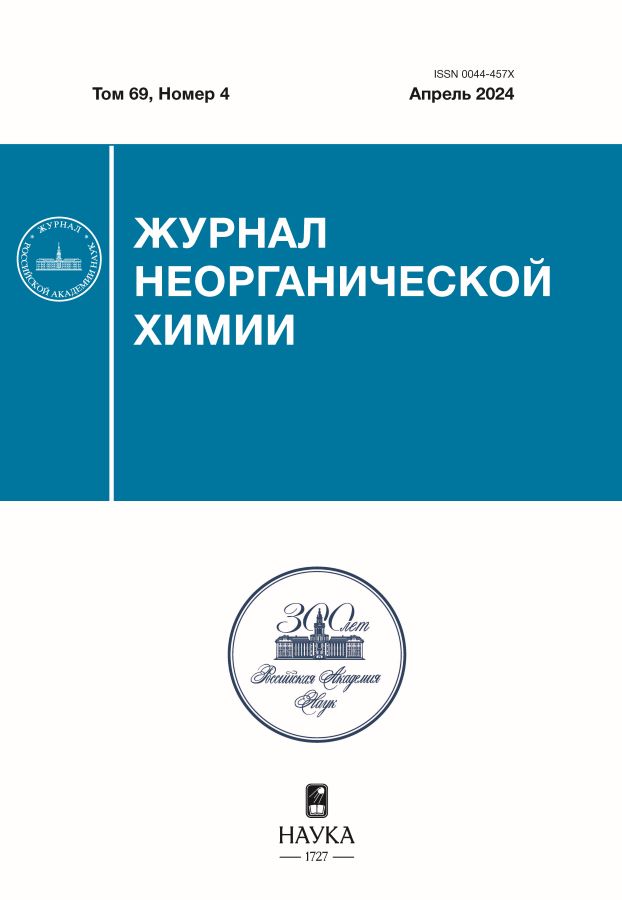Spectral properties of tolan and its supramolecular complexes in solution and silicate hydrogel
- 作者: Novitskii G.O.1, Medvedeva A.A.1, Koshkin A.V.1, Vedernikov A.I.1, Lobova N.A.1,2
-
隶属关系:
- Photochemistry Center of the Russian Academy of Sciences, Federal Research Center “Crystallography and Photonics” – National Research Center “Kurchatov Institute”
- Moscow Institute of Physics and Technology
- 期: 卷 69, 编号 4 (2024)
- 页面: 528-536
- 栏目: ФИЗИКОХИМИЯ РАСТВОРОВ
- URL: https://cijournal.ru/0044-457X/article/view/666567
- DOI: https://doi.org/10.31857/S0044457X24040087
- EDN: https://elibrary.ru/ZYHXKG
- ID: 666567
如何引用文章
详细
The complexation process of tolane and α-cyclodextrin in water, aqueous-ethanol solution and silicate hydrogel based on tetrakis(2 hydroxyethyl)orthosilicate was studied. The complex formation in solutions were confirmed by electron and 1H NMR spectroscopy, and the stability constant of the complex was determined using spectrofluorimetric titration (lgK1:1 = 1.5). The preservation of the inclusion complex during the preparation of the gel was confirmed by electron spectroscopy.
全文:
作者简介
G. Novitskii
Photochemistry Center of the Russian Academy of Sciences, Federal Research Center “Crystallography and Photonics” – National Research Center “Kurchatov Institute”
编辑信件的主要联系方式.
Email: georg.nov97@gmail.com
俄罗斯联邦, Moscow, 119421
A. Medvedeva
Photochemistry Center of the Russian Academy of Sciences, Federal Research Center “Crystallography and Photonics” – National Research Center “Kurchatov Institute”
Email: georg.nov97@gmail.com
俄罗斯联邦, Moscow, 119421
A. Koshkin
Photochemistry Center of the Russian Academy of Sciences, Federal Research Center “Crystallography and Photonics” – National Research Center “Kurchatov Institute”
Email: georg.nov97@gmail.com
俄罗斯联邦, Moscow, 119421
A. Vedernikov
Photochemistry Center of the Russian Academy of Sciences, Federal Research Center “Crystallography and Photonics” – National Research Center “Kurchatov Institute”
Email: georg.nov97@gmail.com
俄罗斯联邦, Moscow, 119421
N. Lobova
Photochemistry Center of the Russian Academy of Sciences, Federal Research Center “Crystallography and Photonics” – National Research Center “Kurchatov Institute”; Moscow Institute of Physics and Technology
Email: georg.nov97@gmail.com
俄罗斯联邦, Moscow, 119421; Dolgoprudny, 141701
参考
- Wilson A. J. // Annu. Rep. Prog. Chem., Sect.B: Org. 2007. V. 103. P. 174. https://doi.org/10.1039/b614407c
- Pistolis G., Balomenou I. // J. Phys. Chem. B 2006. V. 110. № 33. P. 16428. https://doi.org/10.1021/jp062003p
- Tian T., Wang Y., Zhang W. et al. // ACS Photonics 2020. V. 7. № 8. P. 2132. https://doi.org/10.1021/acsphotonics.0c00602
- Connors K.A. // Chem. Rev. 1997. V. 97. № 5. P. 1325. https://doi.org/10.1021/cr960371r
- Dodziuk H. // Molecules with Holes – Cyclodextrins, 2006. https://doi.org/10.1002/3527608982.ch1
- Walter G., Coche A. // Nucl. Instruments Methods 1963. V. 23. № C. P. 147. https://doi.org/10.1016/0029-554X(63)90027-2
- Aurisicchio C., Ventura B., Bonifazi D. et al. // J. Phys. Chem. C 2009. V. 113. № 41. P. 17927. https://doi.org/10.1021/jp9053988
- Menning S., Kra M., Coombs B.A. et al. // J Am Chem Soc 2013. V. 135. P. 2160. https://doi.org/10.1021/ja400416r
- Saifi A., Joseph J.P., Singh A.P. et al. // ACS Omega 2021. V. 6. № 7. P. 4776. https://doi.org/10.1021/acsomega.0c05684
- Asiri A.M., El-Daly S.A., Khan S.A. // Spectrochim. Acta – Part A Mol. Biomol. Spectrosc. 2012. V. 95. P. 679. https://doi.org/10.1016/j.saa.2012.04.077
- Al-Sherbini E.S.A.M. // Microporous Mesoporous Mater. 2005. V. 85. № 1–2. P. 25. https://doi.org/10.1016/j.micromeso.2005.06.016
- Dolinina E.S., Parfenyuk E.V. // Russ. J. Inorg. Chem. 2022. V. 67. № 3. P. 401. https://doi.org/10.1134/S0036023622030068
- Buslaeva T.M., Ehrlich, G.V., Volchkova E.V. et al. // Russ. J. Inorg. Chem. 2022. V. 67. P. 1191. https://doi.org/10.1134/S0036023622080058
- Ooya T., Kobayashi N., Ichi T. et al. // Sci. Technol. Adv. Mater. 2003. V. 4. № 1. P. 39. https://doi.org/10.1016/S1468-6996(03)00003-2
- Koshkin A.V., Aleksandrova N.A., Ivanov D.A. // J. Sol-Gel Sci. Technol. 2017. V. 81. № 1. P. 303. https://doi.org/10.1007/s10971-016-4183-0
- Brandhuber D., Torma V., Raab C. et al. // Chem. Mater. 2005. V. 17. № 3. P. 4262. https://doi.org/10.1021/cm048483j
- Castellano S., Lorenc J. // J. Phys. Chem. 1965. V. 69. № 10. P. 3552. https://doi.org/10.1021/j100894a051
- Armitage J.B., Entwistle N., Jones E.R.H.W.M.C. // J. Chem. Soc. 1954. V. 147. № 111. P. 147. https://doi.org/10.1039/JR9540000147
- Du H., Fuh R.C.A., Li J. et al. // Photochem. Photobiol. 1998. V. 68. № 2. P. 141. https://doi.org/10.1111/j.1751-1097.1998.tb02480.x
- Gans P., Sabatini A., Vacca A. // Talanta 1996. V. 43. № 10. P. 1739. https://doi.org/10.1016/0039-9140(96)01958-3
- Li Z., Sun S., Liu F. et al. // Dye. Pigment. 2012. V. 93. № 1–3. P. 1401. https://doi.org/10.1016/j.dyepig.2011.10.005
- Shchipunov Y.A., Karpenko T.Y., Bakunina I.Y. et al. // J. Biochem. Biophys. Methods 2004. V. 58. № 1. P. 25. https://doi.org/10.1016/S0165-022X(03)00108-8
- Koshkin A.V., Medvedeva A.A., Lobova N.A. // High Energy Chem. 2019. V. 53. № 6. P. 444. https://doi.org/10.1134/S0018143919060110
补充文件



















